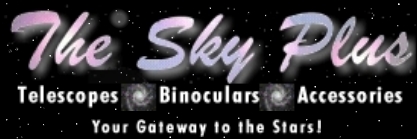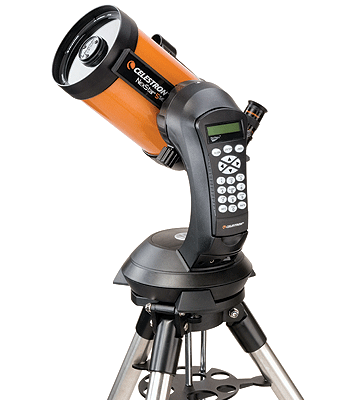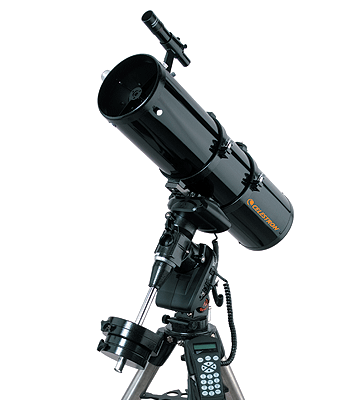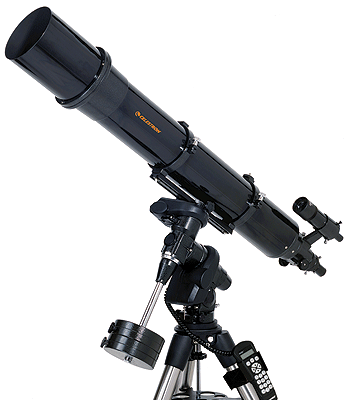 |
Telescopes
Brief Description
Catadioptrics
Schmidt-Cassegrain
Features
The optical tube is short because the light path is "folded" inside. Light enters through a "corrector" lens at the front of the telescope and is reflected off the primary mirror to an adjustable, magnifying secondary mirror on the inside of the corrector plate. The light beam is then directed out the back of the tube to the eyepiece.
Maksutov-Cassegrain
Features
The optical design is similar to that of the Schmidt, Light enters through a multicoated meniscus lens, proceeds to the primary mirror, and then to a convex secondary mirror that multiplies the effective focal length. The secondary mirror light baffle, in combination with the anti-reflection threads inside the primary mirror baffle, produces extremely high contrasting astronomical images at the focal plane. The primary mirror results in a fully-illuminated (undigested) field of view.
Recommended Accessories
Telrad, 3 Plossl eyepieces of different powers (high, middle and low), deluxe barlow lens, finderscope, lunar filter, solar and nebula filters, motor drive, reducer-corrector, vibration suppression pads (optional)
Use
Excellent all-around, all purpose telescope design. Combines the optical advantages of both lenses and mirrors. The compact design and versatility of the Schmidt- and Maksutov-Cassegrain has made them popular telescope types among amateur astronomers.
Newtonian Reflector
Features
A reflector focuses light with mirrors, as opposed to refractors which use lenses. Incoming light is reflected off a concave "primary" mirror at the base of the optical tube up to a smaller, flat "secondary" mirror near the front end. The light is deflected out of the optical tube into the eyepiece.
Recommended Accessories
Telrad, 3 Plossl eyepieces of different powers (high, middle and low), deluxe barlow lens, finderscope, lunar filter, solar and nebula filters, motor drive, vibration suppression pads (optional)
Use
Excellent for faint deep sky objects such as remote galaxies, nebulae and star clusters due to their focal ratios (f/4 to f/8)
Refractor
Features
Refractor telescopes have long, thin tubes where light passes in a straight line from the front objective lens directly to the eyepiece at the opposite end of the tube. Unlike Newtonians and Schmidt-Cassegrains , Refractors do not have primary mirrors. Their distinctive feature is that they have crown glass built into their achromatic objective lenses.
Recommended Accessories
Telrad, 3 Plossl eyepieces of different powers (high, middle and low), deluxe barlow lens, finderscope, lunar filter, solar and nebula filters, motor drive, vibration suppression pads (optional)
Use
Refractors tend to be more expensive per inch of aperture than Newtonians and are primarily planetary telescopes. They are also excellent for lunar and binary star observing.
The Sky Plus provides a free astronomy and telescope set-up lesson with each telescope purchase so that you can learn to use your telescope at its full potential. Not only that! We will make sure that you are familiar with all of its features before you leave our store.
Out of town? No problem. We will gladly talk you through setting up your telescope on the phone or internet. Give us a call and get helpful tips on using your telescope.
Please remember to review our advice on selecting a telescope!
Please check our Frequently Asked Questions for more information!
|
[
Products and Services
|
Selecting a First Telescope
] [ Free Lessons | Make an Appointment | Beginner Telescope Use ] [ Advanced Telescope Use | FAQ | Contact Us | Order Now | Links | Lunar Map ] |
Everything on this site is copyright © 2009 by The Sky Plus
Celestron is a copyright © held by Celestron International
Copyright © 2009 Meade Instruments Corporation
The Sky Plus is an authorized Celestron Dealer
Contact The Sky Plus


